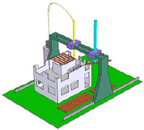February 06, 2006
Making the Virtual Real

reBang(ing) via 3D Printers
As we move into the fabrication future, we'll see a surprising cross-over between the skills of virtual world designers and the skills of designers of physical objects.
We're all familiar by now with the idea of real money being used to buy virtual goods, and even with virtual money being used to buy physical goods. The intersection of online worlds and the real world doesn't stop there, however. It turns out that the increasing detail of 3D objects in virtual environments makes it possible to think of them not simply as game objects, but as digital prototypes -- and 3D printers are the tool of choice for turning the prototypes into real objects. WorldChanging ally Csven Johnson is at the forefront of this movement. On his blog reBang, he discusses his efforts to convert the game data for objects into CAD data usable with rapid prototyping hardware.
The metaverse is not just an ethereal “storyteller’s” world. It’s a world comprised of data. Just look at the reasons Marketing people are salivating over it. The tracking data is orders of magnitude better than trying to count eyeballs watching a television screen. And in a 3D interface (which is what those videogames really are), that data goes well beyond just “hits” or “click-throughs”- it’s comprised of “vectors” and “3D positional data”. And here’s the important part: that data can be converted into more than just marketing statistics. It can be converted into real product; something you can hold… in the flesh. The Story made Real.
The image above [At left here -- Jamais] is a screen capture from Pro/ENGINEER CAD, perhaps the most widely used product development 3D application for design and manufacturing. That object is a piece of a virtual game object “captured” from id’s Quake 3 videogame (the barrel of a Rocket Launcher). It was not created in my CAD application. It was not ripped from the game files. I “hijacked” the data streaming to my monitor using a freely available tool. And now, if I desired, I could manipulate the data and create a real product...
...Don't get tripped up by the example being a "rocket launcher" that wouldn't work in the real world. The tools for creating virtual objects in or for games have become startlingly sophisticated, while in many cases becoming much easier to use. Some games, like Second Life, allow players to craft complex goods, from weapons to furniture to clothing, as well as design buildings. A home 3D printer of the near future may not be able to (or allowed to) print out a working gun -- and I would expect few people would complain about that -- but it almost certainly would be able to print out a chair, and probably be able to print out some kinds of clothing... [Posted by Jamais Cascio on WorldChanging]
Related:

OGLE and the Second Life Avatar
Having played with the OGLE tool for a few days (version 1b), I’ve learned some things that might be helpful to those hoping to have their customized Second Life avatars or objects fabricated. My own goal is to take the avatar geometry and convert it to “solid” CAD data, but the process I’m using to get there might be useful even if your goal is to just send out an .obj or .stl polymesh file.
First off, be aware that the captured videostream data most likely isn’t “clean”… even if it looks good. Be sure to search for duplicate triangles/polymeshes since there will probably be plenty. After deleting any duplicates, be sure to select and “merge” all the remaining polygon edges and vertices since there will almost certainly be multiples of those as well... [blogged by Csven Johnson on reBang]
Posted by jo at February 6, 2006 03:55 PM
